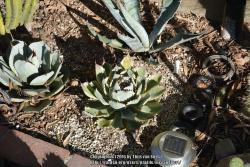Those terminal spines are much smaller compared to Cream Spike. The plant in my picture is roughly the same size (10-11 inches).
Cream Spike is a variegated form of Agave applanata but has been referred to using various other species names. The small butterfly agaves (Kissho Kan etc.) are dwarf forms of a different species (probably potatorum). Aside from being different species, they are also quite different in how they grow. This behavior is the way you can usually tell them apart. Cream Spike starts out as a very flat, low plant when it is young and ends up a very symmetric upright adult plant with erect leaves that fill in the space quite evenly. The transition starts around the time the plant is about 6 inches in diameter but takes a few years to really transform the plant (which is notoriously slow to make this transition). Agave applanata is not a dwarf plant when it grows up, whatever the juvenile form may suggest. Cream Spikes can grow to a couple of feet wide (or more), the normal (non-variegated) applanatas maybe 3 times that big.
The butterfly agaves are also different in the way the leaves open (or often stay slightly folded after opening), resembling a pair of wings perhaps fluttering in the air. In contrast Cream Spike leaves tend to be flat (the name applanata means flattened) and don't display the same kind of flutter. For example if you do a Google image search for "Agave Cream Spike" you get a nice page full of images but one stands out right away as different, and that is a fluttering Kissho Kan that was misidentified, on this page.
http://gardenforeplay.avantgar...

